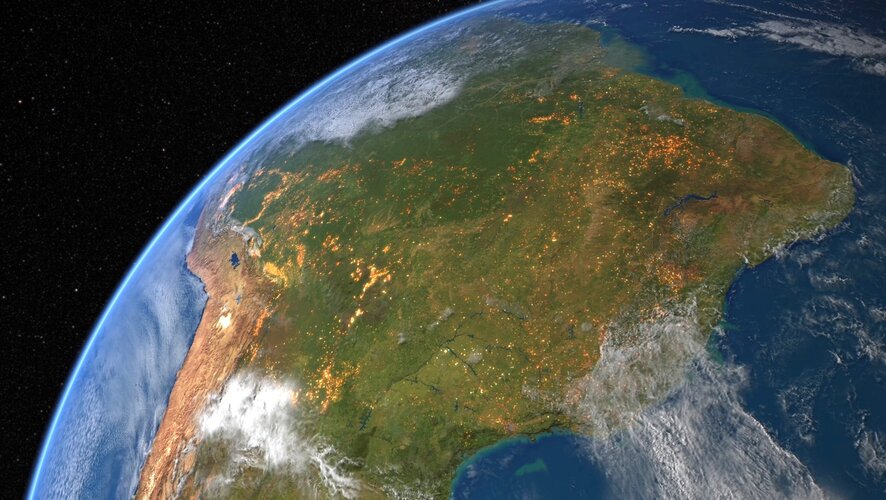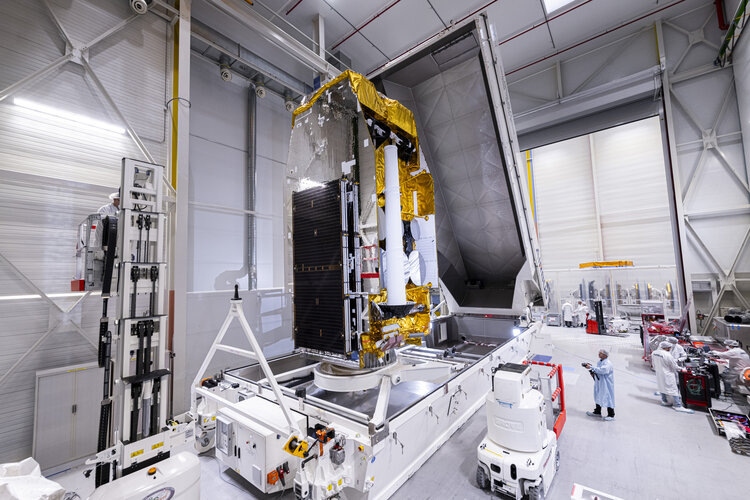
Copernical Team
NASA's Artemis II rocket booster stacking process reaches new milestone
 Assembly of the Artemis II moon rocket has reached its latest milestone with the stacking of the twin boosters' right forward center segment, NASA announced Friday.
The most recent addition is the sixth of the 10 motor segments in the Artemis II Space Launch System rocket to be integrated onto mobile launcher 1 inside the Vehicle Assembly Building at NASA's Kennedy Space Center in Flori
Assembly of the Artemis II moon rocket has reached its latest milestone with the stacking of the twin boosters' right forward center segment, NASA announced Friday.
The most recent addition is the sixth of the 10 motor segments in the Artemis II Space Launch System rocket to be integrated onto mobile launcher 1 inside the Vehicle Assembly Building at NASA's Kennedy Space Center in Flori Smouldering woody debris fuels air pollution over the Amazon

A groundbreaking study, funded by ESA, reveals that fire emissions in the Amazon and Cerrado are largely driven by the smouldering combustion of woody debris. This crucial discovery highlights the significant influence of fuel characteristics on fire emissions, with wide-ranging implications for global carbon cycles, air quality and biodiversity.
ESA and Hisdesat set to launch next-generation secure communications satellite

Hisdesat, Spain's premier provider of secure satellite communications, is set to launch its SpainSat Next Generation I (SNG I) satellite aboard a SpaceX Falcon 9 rocket on 29 January from Cape Canaveral, Florida at 20:34 EST (30 January at 02:34 CET). The European Space Agency (ESA)-supported satellite will provide more cost-effective, adaptable and secure communication services for governments and emergency response teams across Europe, North and South America, Africa, the Middle East and up to Singapore in Asia.
China launches additional satellites for Spacesail Constellation
 China successfully launched 18 new satellites on Thursday as part of the ongoing expansion of the Spacesail Constellation. The satellites were sent into orbit from the Taiyuan Satellite Launch Center in Shanxi province, utilizing a modified Long March 6 carrier rocket.
The launch occurred at 1:15 pm Beijing Time, marking the sixth satellite deployment for the Spacesail Constellation. Each
China successfully launched 18 new satellites on Thursday as part of the ongoing expansion of the Spacesail Constellation. The satellites were sent into orbit from the Taiyuan Satellite Launch Center in Shanxi province, utilizing a modified Long March 6 carrier rocket.
The launch occurred at 1:15 pm Beijing Time, marking the sixth satellite deployment for the Spacesail Constellation. Each Mining the dark sky with advanced cosmological simulations
 Researchers are utilizing the Aurora supercomputer to conduct expansive cosmological simulations aimed at unraveling the enigmas of dark matter and dark energy.
Scientists at the U.S. Department of Energy's (DOE) Argonne National Laboratory are on a quest to understand the most elusive components of the universe. Their work has the potential to answer enduring questions about cosmic evolut
Researchers are utilizing the Aurora supercomputer to conduct expansive cosmological simulations aimed at unraveling the enigmas of dark matter and dark energy.
Scientists at the U.S. Department of Energy's (DOE) Argonne National Laboratory are on a quest to understand the most elusive components of the universe. Their work has the potential to answer enduring questions about cosmic evolut GMV to advance the Galileo High Accuracy Service with new data generator
 The European Union Agency for the Space Programme (EUSPA) has chosen GMV, a multinational technology leader, to develop a new iteration of the High Accuracy Data Generator (HADG) as part of Phase 2 of the Galileo High Accuracy Service (HAS). This service, which is a global pioneer, provides free real-time positioning corrections to all users. GMV was also responsible for the first version of the
The European Union Agency for the Space Programme (EUSPA) has chosen GMV, a multinational technology leader, to develop a new iteration of the High Accuracy Data Generator (HADG) as part of Phase 2 of the Galileo High Accuracy Service (HAS). This service, which is a global pioneer, provides free real-time positioning corrections to all users. GMV was also responsible for the first version of the NASA's OSIRIS-APEX completes 2nd perihelion of solar orbit
 NASA's OSIRIS-APEX (Origins, Spectral Interpretation, Resource Identification and Security - Apophis Explorer) spacecraft has successfully completed its second perihelion passage, reaching within 46.5 million miles of the Sun - between the orbits of Mercury and Venus - without exceeding its heat tolerances.
On January 23, 2025, the mission team finalized its review of data collected during
NASA's OSIRIS-APEX (Origins, Spectral Interpretation, Resource Identification and Security - Apophis Explorer) spacecraft has successfully completed its second perihelion passage, reaching within 46.5 million miles of the Sun - between the orbits of Mercury and Venus - without exceeding its heat tolerances.
On January 23, 2025, the mission team finalized its review of data collected during Eutelsat and NIGCOMSAT forge partnership to expand satellite services in Nigeria
 NIGCOMSAT has announced a major multi-year, multi-million-dollar partnership aimed at introducing low Earth orbit (LEO) satellite services in Nigeria. This pivotal agreement designates NIGCOMSAT as the primary satellite service provider in Nigeria, leveraging the OneWeb LEO satellite network to deliver high-speed, low-latency connectivity.
NIGCOMSAT has announced a major multi-year, multi-million-dollar partnership aimed at introducing low Earth orbit (LEO) satellite services in Nigeria. This pivotal agreement designates NIGCOMSAT as the primary satellite service provider in Nigeria, leveraging the OneWeb LEO satellite network to deliver high-speed, low-latency connectivity. Zenno expands superconducting space technologies in Japan
 New Zealand-based Zenno Astronautics (Zenno) has entered into a Memorandum of Understanding (MOU) with ANA Trading to introduce Zenno's superconducting space technologies to the Japanese market.
ANA Trading, a division of Japan's premier airline conglomerate ANA Group, is leveraging its aerospace expertise under the group's strategic initiative, "Next Stop, Space," to explore space-focused
New Zealand-based Zenno Astronautics (Zenno) has entered into a Memorandum of Understanding (MOU) with ANA Trading to introduce Zenno's superconducting space technologies to the Japanese market.
ANA Trading, a division of Japan's premier airline conglomerate ANA Group, is leveraging its aerospace expertise under the group's strategic initiative, "Next Stop, Space," to explore space-focused National Astronomy Week illuminates February with rare planet parade
 A rare celestial display featuring Venus, Mars, Jupiter, and Saturn will dazzle stargazers during National Astronomy Week 2025, which runs from February 1-9. Complementing the planet parade, the Moon will pass through its phases from crescent to nearly full, creating a spectacular backdrop.
More than 250 activities, including stargazing events, planetarium shows, and talks, are planned acr
A rare celestial display featuring Venus, Mars, Jupiter, and Saturn will dazzle stargazers during National Astronomy Week 2025, which runs from February 1-9. Complementing the planet parade, the Moon will pass through its phases from crescent to nearly full, creating a spectacular backdrop.
More than 250 activities, including stargazing events, planetarium shows, and talks, are planned acr 
